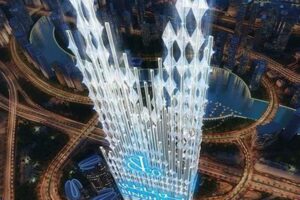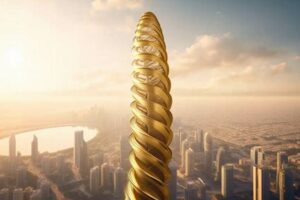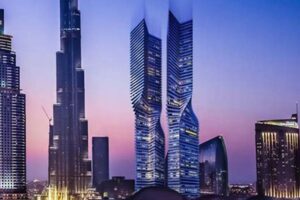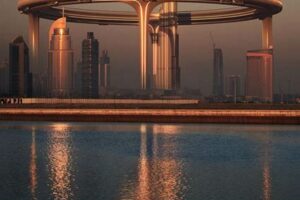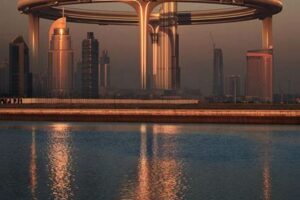Dubai is known for its impressive skyline, dominated by tall skyscrapers that have become iconic landmarks. These structures are architectural marvels, pushing the boundaries of engineering and design, and serve as symbols of Dubai’s economic growth and ambition.
The Burj Khalifa, completed in 2010, stands as the tallest building in the world, soaring 828 meters (2,717 feet) into the sky. It boasts 163 floors and offers breathtaking views from its observation deck. Other notable skyscrapers include the Princess Tower, 23 Marina, and the Cayan Tower, each with its unique architectural features and amenities.
These tall skyscrapers serve multiple purposes. They house luxury apartments, offices, hotels, and retail spaces, contributing to Dubai’s vibrant urban environment. They also attract tourists from around the globe, eager to witness these architectural wonders. Moreover, these structures have played a significant role in shaping Dubai’s identity as a global metropolis and a hub for business and tourism.
1. Height
The height of the Burj Khalifa is a testament to Dubai’s ambition and its . This drive has been a key factor in the development of Dubai’s impressive skyline and its reputation as a city of architectural wonders.
- Symbol of National Pride
The Burj Khalifa is a source of immense national pride for the people of the United Arab Emirates. It is a symbol of their country’s economic and technological achievements and a reminder of their ambition to be a global leader. - Architectural Innovation
The Burj Khalifa’s height and unique design have pushed the boundaries of architectural engineering. The building’s structural system, wind-resistant design, and innovative materials have made it an architectural marvel. - Tourism Destination
The Burj Khalifa is a major tourist attraction, drawing visitors from around the world. Tourists can ascend to the observation deck, At the Top, for panoramic views of Dubai and beyond. - Economic Impact
The construction and operation of the Burj Khalifa have had a significant economic impact on Dubai. The project created thousands of jobs and boosted the city’s real estate market.
The height of the Burj Khalifa is not just a number; it is a reflection of Dubai’s aspirations and its commitment to excellence. The building stands as a symbol of the city’s determination to reach new heights and to be a global leader in architecture, engineering, and innovation.
2. Design
The distinctive architectural designs of Dubai’s skyscrapers are an integral part of what makes them so iconic and recognizable worldwide. Each building is a testament to the creativity and innovation of the architects and engineers who designed them.
The Burj Al Arab, for example, is shaped like a billowing sail, giving it a unique and eye-catching appearance. The Cayan Tower, on the other hand, is known for its twisted shape, which creates a dynamic and visually interesting effect.
These unique designs are not merely aesthetic choices; they also serve practical purposes. The sail shape of the Burj Al Arab, for example, helps to reduce wind resistance and improve the building’s stability. The twisted shape of the Cayan Tower allows for more efficient use of space and provides panoramic views from each apartment.
The innovative designs of Dubai’s skyscrapers have pushed the boundaries of architectural engineering and set new standards for tall buildings worldwide. They have also made Dubai a global destination for tourists and architects alike, who come to marvel at these architectural wonders.
3. Purpose
The diverse purposes of Dubai’s tall skyscrapers are central to their significance and impact on the city. These buildings are not merely architectural wonders; they are also vibrant and functional hubs that cater to a wide range of needs.
- Residential living
Dubai’s tall skyscrapers offer luxurious and spacious apartments, providing residents with stunning views of the city and its surroundings. These apartments are highly sought-after by both local and international buyers, contributing to Dubai’s thriving real estate market. - Commercial offices
The skyscrapers also house numerous commercial offices, providing businesses with prime locations in the heart of Dubai’s business districts. These offices offer state-of-the-art facilities and amenities, attracting multinational corporations and startups alike. - Hospitality and tourism
Several tall skyscrapers in Dubai are home to world-renowned hotels, offering guests luxurious accommodations and exceptional dining experiences. These hotels play a vital role in Dubai’s tourism industry, attracting visitors from around the globe. - Retail and entertainment
The skyscrapers also feature extensive retail spaces, housing a wide range of shops, boutiques, and restaurants. These retail offerings cater to the diverse needs of residents, tourists, and visitors, contributing to Dubai’s vibrant urban environment.
The diverse purposes of Dubai’s tall skyscrapers have created a dynamic and multifaceted urban environment. These buildings are not just symbols of architectural achievement; they are also essential components of the city’s economy, real estate market, and overall lifestyle.
4. Engineering
The advanced engineering techniques employed in the construction of Dubai’s tall skyscrapers are crucial to ensuring their safety and durability in the face of extreme environmental conditions.
- Structural Design
Skyscrapers in Dubai are engineered to withstand high winds and seismic activity. They use reinforced concrete and steel frames to create strong and stable structures that can resist lateral forces. - Wind Resistance
The shape and design of Dubai’s skyscrapers are carefully considered to minimize wind resistance. Many buildings feature aerodynamic curves and setbacks that reduce wind loads and prevent swaying. - Thermal Insulation
Dubai’s skyscrapers are equipped with advanced thermal insulation systems to protect against the extreme heat. Reflective glass and shading devices are used to reduce heat gain, while ventilation systems ensure comfortable indoor temperatures. - Fire Safety
Skyscrapers in Dubai are equipped with comprehensive fire safety systems, including sprinklers, fire alarms, and evacuation plans. The buildings are designed to compartmentalize fire and smoke, preventing its spread and ensuring the safety of occupants.
The engineering techniques employed in Dubai’s tall skyscrapers demonstrate the commitment to safety and durability. These buildings are designed to withstand the most extreme environmental conditions, ensuring the well-being of occupants and the longevity of these iconic structures.
5. Tourism
The connection between tourism and tall skyscrapers in Dubai is undeniable. These iconic structures have become major tourist attractions, drawing visitors from around the world to witness their architectural grandeur. The unique designs, impressive heights, and innovative engineering of these buildings have made them popular destinations for tourists and architecture enthusiasts alike.
The tourism industry plays a vital role in Dubai’s economy, and the city’s tall skyscrapers are a significant part of that. The Burj Khalifa, for example, is one of the most visited tourist attractions in the world, with over 1.8 million visitors in 2019. Tourists come from all over the globe to see this iconic building and experience the breathtaking views from its observation deck.
The success of Dubai’s tall skyscrapers as tourist attractions has led to the development of a number of related businesses and services. Many hotels, restaurants, and tour operators have opened up in the vicinity of these buildings, catering to the needs of tourists. The tourism industry has also created employment opportunities for local residents, contributing to the city’s overall economic growth.
In conclusion, the relationship between tourism and tall skyscrapers in Dubai is mutually beneficial. The skyscrapers have become major tourist attractions, drawing visitors from around the world and contributing to the city’s economy. In turn, the tourism industry has supported the development and success of these iconic buildings.
6. Sustainability
The incorporation of sustainable features in Dubai’s tall skyscrapers is a testament to the city’s commitment to environmental responsibility while maintaining its architectural ambitions. These buildings employ various eco-friendly technologies to reduce their environmental impact and promote sustainable practices.
- Energy Efficiency
Many skyscrapers in Dubai are equipped with energy-efficient lighting systems, including LED lights and motion sensors. These systems reduce energy consumption and contribute to lower operating costs. The Emirates Towers, for example, uses an intelligent lighting system that adjusts the intensity of lights based on daylight availability, saving significant amounts of energy. - Water Conservation
Water scarcity is a major concern in Dubai, and skyscrapers are playing a role in conserving this precious resource. Buildings like the Burj Khalifa utilize innovative plumbing fixtures and irrigation systems that reduce water usage. Additionally, rainwater harvesting systems are employed to collect and reuse rainwater for non-potable purposes. - Sustainable Materials
Some skyscrapers in Dubai incorporate sustainable building materials, such as recycled steel and glass, to minimize their environmental footprint. These materials have a lower carbon footprint and reduce the depletion of natural resources. - Green Spaces
Several skyscrapers in Dubai feature green spaces, such as rooftop gardens and vertical gardens. These green spaces not only enhance the aesthetic appeal of the buildings but also contribute to air purification, reduce the urban heat island effect, and provide habitats for wildlife.
The integration of sustainable features in Dubai’s tall skyscrapers showcases the city’s commitment to balancing its economic growth with environmental preservation. These buildings serve as examples of how sustainability can be incorporated into ambitious architectural projects, inspiring other cities to adopt similar practices.
7. Economic impact
The construction and operation of tall skyscrapers in Dubai have a significant economic impact on the city and the region. These projects create thousands of jobs and boost the real estate market, contributing to Dubai’s economic growth and development.
During the construction phase, skyscrapers require a large workforce, including architects, engineers, construction workers, and laborers. These jobs provide income and support for many families. Additionally, the purchase of materials and equipment for construction stimulates various industries, such as manufacturing, transportation, and logistics.
Once completed, tall skyscrapers generate ongoing economic benefits. They house offices, apartments, retail spaces, and hospitality venues, attracting businesses, residents, and tourists. This increased demand for commercial and residential spaces leads to higher rental and property values, boosting the real estate market and generating revenue for investors and developers.
The economic impact of tall skyscrapers extends beyond the construction and real estate sectors. They serve as landmarks and tourist attractions, drawing visitors from around the world. This influx of tourism supports businesses such as hotels, restaurants, and tour operators, creating additional jobs and revenue streams.
In summary, the construction and operation of tall skyscrapers in Dubai have a significant economic impact. These projects create jobs, boost the real estate market, stimulate various industries, and support tourism. Understanding this economic impact is crucial for policymakers, investors, and businesses seeking to capitalize on the opportunities presented by these architectural marvels.
FAQs about Tall Skyscrapers in Dubai
This section addresses frequently asked questions about tall skyscrapers in Dubai, providing concise and informative answers to common concerns or misconceptions.
Question 1: What is the tallest building in Dubai?
The tallest building in Dubai is the Burj Khalifa, standing at an impressive 828 meters (2,717 feet) tall.
Question 2: How many skyscrapers are there in Dubai?
As of 2023, Dubai boasts over 200 completed skyscrapers, with numerous others under construction or in the planning stages.
Question 3: Are skyscrapers in Dubai earthquake-proof?
Yes, skyscrapers in Dubai are designed to withstand earthquakes. They employ advanced engineering techniques and materials to ensure structural stability and safety in the event of seismic activity.
Question 4: Are skyscrapers in Dubai energy-efficient?
Increasingly, skyscrapers in Dubai incorporate sustainable features to improve energy efficiency. These features include energy-efficient lighting, water conservation systems, and the use of recycled materials.
Question 5: What is the economic impact of skyscrapers in Dubai?
The construction and operation of skyscrapers in Dubai have a significant economic impact. They create jobs, boost the real estate market, and support tourism, contributing to the city’s overall economic growth.
Question 6: Are skyscrapers in Dubai safe?
Skyscrapers in Dubai adhere to strict safety regulations and building codes. They are equipped with advanced fire safety systems, evacuation plans, and structural designs to ensure the safety of occupants.
In conclusion, tall skyscrapers in Dubai are marvels of engineering and architectural innovation. They contribute to the city’s economic growth, sustainability efforts, and global recognition as a modern metropolis.
Transition to the next article section: Exploring the Architectural Significance of Dubai’s Skyscrapers
Tips for Experiencing Dubai’s Tall Skyscrapers
Dubai’s tall skyscrapers offer a unique and awe-inspiring experience. Here are some tips to make the most of your visit:
Plan your visit: Decide which skyscrapers you want to visit and research their opening hours and ticket prices. Consider purchasing tickets in advance, especially during peak tourist season, to avoid queues.
Arrive early: Arrive at the skyscraper early to secure a good spot for viewing or taking photographs. This is particularly important for popular observation decks, where lines can be long.
Take your time: Don’t rush your visit. Take time to appreciate the architectural details of the buildings, both inside and out. Use binoculars to enhance your view from observation decks.
Capture the moment: Bring a camera to capture the stunning views and architectural details. Consider using a tripod for stability, especially during nighttime photography.
Respect the rules: Adhere to the rules and regulations of each skyscraper. This includes following safety guidelines, not using flash photography in certain areas, and being mindful of noise levels.
Consider a guided tour: Guided tours can provide valuable insights into the history, design, and engineering of the skyscrapers. They can also take you to exclusive areas not accessible to the general public.
By following these tips, you can ensure a safe, enjoyable, and memorable experience when visiting Dubai’s tall skyscrapers.
Conclusion: Dubai’s tall skyscrapers are architectural marvels that offer breathtaking views and unforgettable experiences. With careful planning and by following these tips, you can make the most of your visit and appreciate the grandeur of these iconic structures.
Conclusion
The tall skyscrapers in Dubai are architectural marvels that have reshaped the city’s skyline and transformed it into a global metropolis. These iconic structures represent not only engineering prowess but also economic growth and ambition. Their height, design, purpose, engineering, and economic impact have made Dubai a global destination for tourism, business, and investment.
As Dubai continues to grow and evolve, its skyscrapers will undoubtedly continue to play a significant role in shaping the city’s future. They serve as symbols of the city’s ambition, innovation, and commitment to excellence. By embracing sustainable practices and incorporating cutting-edge technologies, Dubai’s tall skyscrapers will continue to push the boundaries of architectural engineering and inspire future generations.



